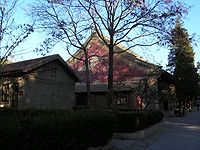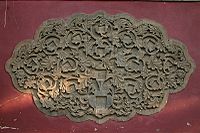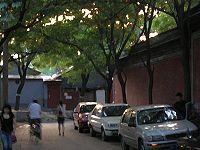
Bailin Temple (Beijing)
Encyclopedia

Beijing
Beijing , also known as Peking , is the capital of the People's Republic of China and one of the most populous cities in the world, with a population of 19,612,368 as of 2010. The city is the country's political, cultural, and educational center, and home to the headquarters for most of China's...
, China
China
Chinese civilization may refer to:* China for more general discussion of the country.* Chinese culture* Greater China, the transnational community of ethnic Chinese.* History of China* Sinosphere, the area historically affected by Chinese culture...
.
Imperial Era
Construction of the Bailin Temple started in 1347, under the reign of Emperor Shundi (顺帝) of the Yuan dynastyYuan Dynasty
The Yuan Dynasty , or Great Yuan Empire was a ruling dynasty founded by the Mongol leader Kublai Khan, who ruled most of present-day China, all of modern Mongolia and its surrounding areas, lasting officially from 1271 to 1368. It is considered both as a division of the Mongol Empire and as an...
, in an open tract of land east of the Temple of Confucius
Beijing Temple of Confucius
The Temple of Confucius at Beijing is the second largest Confucian Temple in China, after the one in Confucius' hometown of Qufu.The temple was built in 1302, and officials used it to pay their respects to Confucius until 1911. The compound was enlarged twice, during the Ming and Qing dynasties...
. The temple, the largest of its kind in the capital of Dadu
Khanbaliq
Khanbaliq or Dadu refers to a city which is now Beijing, the current capital of the People's Republic of China...
, was occupied by the Sakya
Sakya
The Sakya school is one of four major schools of Tibetan Buddhism, the others being the Nyingma, Kagyu, and Gelug...
school of Tibetan Buddhism
Tibetan Buddhism
Tibetan Buddhism is the body of Buddhist religious doctrine and institutions characteristic of Tibet and certain regions of the Himalayas, including northern Nepal, Bhutan, and India . It is the state religion of Bhutan...
, which enjoyed great power under the Mongol emperors. The fortunes of the temple, though, were short-lived: in 1355 the Sakya were overthrown in Tibet by local warlords, and the Yuan dynasty would suffer the same fate only 13 years later: in 1368 Dadu was taken by a rebel army and pillaged.
The structure of the Bailin Temple mostly survived the event but the monastery fell into disrepair in the following decades, even though since 1421 the Ming dynasty
Ming Dynasty
The Ming Dynasty, also Empire of the Great Ming, was the ruling dynasty of China from 1368 to 1644, following the collapse of the Mongol-led Yuan Dynasty. The Ming, "one of the greatest eras of orderly government and social stability in human history", was the last dynasty in China ruled by ethnic...
moved the capital back to the North, naming it Beijing. Only in 1447 Emperor Zhengtong ordered a renovation of the monastery, and in the following years a small square developed in front of the temple’s main gate.

Manchu
The Manchu people or Man are an ethnic minority of China who originated in Manchuria . During their rise in the 17th century, with the help of the Ming dynasty rebels , they came to power in China and founded the Qing Dynasty, which ruled China until the Xinhai Revolution of 1911, which...
. Apparently the Bailin Temple did not suffer heavy consequences from the wars. In 1694 a palace for prince Yong, fourteenth son of Emperor Kangxi, was built directly west of the temple: the prestige of the new neighbour resulted in the gift of a monumental bell (1707) and in a complete renovation of the monastery (1713), on occasion of the 60th birthday of Kangxi. The works of renovation were directly supervised by prince Yong himself who, in 1722, succeeded his father on the Imperial Throne as Yongzheng. That same year, the new monarch donated part of his former palace to Tibetan lamas of the Gelug
Gelug
The Gelug or Gelug-pa , also known as the Yellow Hat sect, is a school of Buddhism founded by Je Tsongkhapa , a philosopher and Tibetan religious leader...
school, which would transform it, in a few decades, into the largest Tibetan temple outside Tibet, the Yonghegong Lamasery (雍和宫).
The rise of such monastery resulted into a partial oblivion for Bailin Temple which, by the end of the dynasty, had become dependent on its western counterpart. However, the generosity of Qing Emperors and the wealth of the Gelug school made sure that temple was kept in good repair. In 1758, Emperor Qianlong ordered a lavish renovation of the buildings, part of his great project to shape Beijing into a monument to his power.
Like the Yonghegong Lamasery, Bailin Temple was not touched by the pillages of 1860 by Anglo-French forces and of 1900 by the Eight-Nation Alliance
Eight-Nation Alliance
The Eight-Nation Alliance was an alliance of Austria-Hungary, France, Germany, Italy, Japan, Russia, the United Kingdom, and the United States whose military forces intervened in China to suppress the anti-foreign Boxers and relieve the siege of the diplomatic legations in Beijing .- Events :The...
, because of the superstitious fear that Tibetan Buddhism inspired to the invaders.
Warlords Period
However, as the Empire came to an end in 1911 and the capital was moved to NanjingNanjing
' is the capital of Jiangsu province in China and has a prominent place in Chinese history and culture, having been the capital of China on several occasions...
, Tibetan Buddhism came to be seen as a feudal and non-Han religion and the temples entered into decadence.
According to the property register of the temple in 1931, the abbot was Master Taiyuan. The address for the temple was not 1 Xilou Hutong, but 4 Bailin Temple Hutong. The register records that there were more than 100 Buddhist statues, 18 cypress trees, one pine tree, a pair of steles, one stone spirit wall, one pair of stone lions.
In 1931, the Abbot Taiyuan of Bailin Temple was rather famous in Beijing, and was very active in the upper class circles. According to a memoir by Master Tanxu, Abbot Taiyuan was from northeast China: prior to his conversion, his secular name was Zhang Jiechen. His family was rather wealthy, however after his father died, the wealth was quickly trifled away by family members. In 1924, Zhang Jiechen became a monk under Master Tanxu in Harbin
Harbin
Harbin ; Manchu language: , Harbin; Russian: Харби́н Kharbin ), is the capital and largest city of Heilongjiang Province in Northeast China, lying on the southern bank of the Songhua River...
.
In 1925, Taiyuan came to Beijing. In the following year, the warlord Zhang Zuolin
Zhang Zuolin
Zhang Zuolin was the warlord of Manchuria from 1916 to 1928 . He successfully invaded China proper in October 1924 in the Second Zhili-Fengtian War. He gained control of Peking, including China's internationally recognized government, in April 1926...
became the new leader of the Northern Warlords Government of China. Since Taiyuan came from the same area as Zhang, he soon became friends with Zhang’s Chief of Staff and thus was appointed abbot of Bailin Temple. In 1929, Master Taiyuan and a few Buddhist believers established a Buddhist academy inside the temple grounds. The next year, under the efforts of Master Taixu
Taixu
Venerable Master Taixu , 1890-1947, was a Buddhist modernist, activist and thinker who advocated the reform and renewal of Chinese Buddhism.- Biography :...
, the academy was reorganized on a larger scale. However, in 1931, the war between the Chinese and the Japanese in the Northeast had a serious effect on the financial resources of the temple. In 1932, it was announced that the academy was to close. Since Taiyuan had always lived a rather luxurious life, he eventually decided he could not survive in Beijing anymore and moved to Sichuan
Sichuan
' , known formerly in the West by its postal map spellings of Szechwan or Szechuan is a province in Southwest China with its capital in Chengdu...
, where he later died. Although Taiyuan was active in Beijing for only five or six years, his role in establishing the academy played a major part in advancing the study of Buddhism in Beijing.
People's Republic of China

Red Guards (China)
Red Guards were a mass movement of civilians, mostly students and other young people in the People's Republic of China , who were mobilized by Mao Zedong in 1966 and 1967, during the Cultural Revolution.-Origins:...
, who evacuated the lamas from the area and reorganised the buildings, including dormitories, stables, warehouses and shrines outside the main temples, assigning them to danwei. After this period several brick structures were built inside Bailin Temple’s walls and the screenwall was linked to the main walls to create a closed courtyard; the Drum and Bell Towers were torn down, and the stone lions, the Buddhist statues and two stone tablets displaying the rules to observe inside the temple disappeared. After the Tangshan earthquake (1976), the flow of refugees dramatically increased density in and around the temple.
In 1988 Bailin Temple was designated by the government to host the Cadre Academy of the Ministry of Culture/Central Academy of Cultural Administration (文化部干部学院) and the Beijing Historical Site Preservation Bureau, in addition to other private and public companies’ offices. In 1992 the government funded a renovation of the temple, which restored the original building but did not touch the new ones. Since 2007, the Beijing Cultural Heritage Protection Centre (CHP) also established its headquarters in one of the buildings. In Autumn of the same year a public mill (a stone slab used by the community in ancient time to grind cereals) in front of the temple has been destroyed, as the road has been levelled for easier traffic.
Architecture and Artwork

Four Heavenly Kings
In the Buddhist faith, the Four Heavenly Kings are four gods, each of whom watches over one cardinal direction of the world.The Kings are collectively named as follows:...
), the Hall of Attaining Perfection (Yuanjuxingjuedian), the Mahavira Hall (Daxiongbaodian) and the Vimalakirti Hall or Hall of Bodhisattva Purity (Weimoge).
A horizontally inscribed plaque in the handwriting of Emperor Kangxi which reads "The Everlasting Cypress Grove" (Wangubailin) hangs on the façade of the Mahavira Hall, while statues of the Buddhas of the Three Worlds
Trailõkya
Trailokya has been translated as "three worlds," "three spheres," "three planes of existence," "three realms" and "three regions."...
are found inside. Behind this hall is the Hall of Vimalakirti, containing seven carved and gilded Buddha images dating from the Ming Dynasty.
To the east of the main hall is an auxiliary hall containing two large bronze bells 2.6 metes tall cast in 1707. Their surfaces were cast with bas-reliefs of coiling dragons and mantra
Mantra
A mantra is a sound, syllable, word, or group of words that is considered capable of "creating transformation"...
intoned after a person's death in the hope of gaining passage to the Pure Land
Pure land
A pure land, in Mahayana Buddhism, is the celestial realm or pure abode of a Buddha or Bodhisattva. The various traditions that focus on Pure Lands have been given the nomenclature Pure Land Buddhism. Pure lands are also evident in the literature and traditions of Taoism and Bön.The notion of 'pure...
.
Among the valuable relics in the temple is a complete set of printing blocks for the Tripitaka
Tripiṭaka
' is a traditional term used by various Buddhist sects to describe their various canons of scriptures. As the name suggests, a traditionally contains three "baskets" of teachings: a , a and an .-The three categories:Tripitaka is the three main categories of texts that make up the...
carved in the early 18th century. The collection has 7,240 volumes with a total of 78,230 separate blocks. Carved of high-grade pear wood, the blocks remain in fine condition today except for some minor cracks. The work of carving took six years to complete and was begun in 1733 during the reign of Emperor Yongzheng. However, fewer than 200 copies of the Tripitaka were printed during the ensuing 300 years, one reason why the blocks remain in excellent condition.
The blocks were originally stored in the Hall of Military Eminence (Wuyingdian) in the Palace Museum, but were later transferred back to the temple. They are presently being cared for under the supervision of the Beijing Library.
Location

Bailin Temple is normally accessible only to people related to the institutions hosted in it. The gates open to the public on Cultural Heritage Day (June 8).
Sources =
- Beijing Cultural Heritage Protection Centre's Historical Research on Bailin Temple
- CHP Report on the Condition of Protected Heritage Areas in Beijing Old Town (2007
- 北京市规划委员会 (Beijing Municipal City Planning Commission), 北京旧城二十五片历史文化保护区保护规划 (Conservation of 25 Historic Areas in Beijing Old City), 北京燕山出版社 (Beijing Yanshan Chubanshe), 2002
- Xu Chengbei, Old Beijing – In the Shadow of the Imperial Throne, Foreign Languages Press 2001
- 1950北京市街道详图 (Complete Street Map of Beijing 1950), 中国地图出版社 (Zhongguo Ditu Chubanshe), 2004
- 北京历史地图 (Historical Maps of Beijing),北京燕山出版社 (Beijing Lishi Chubanshe)

